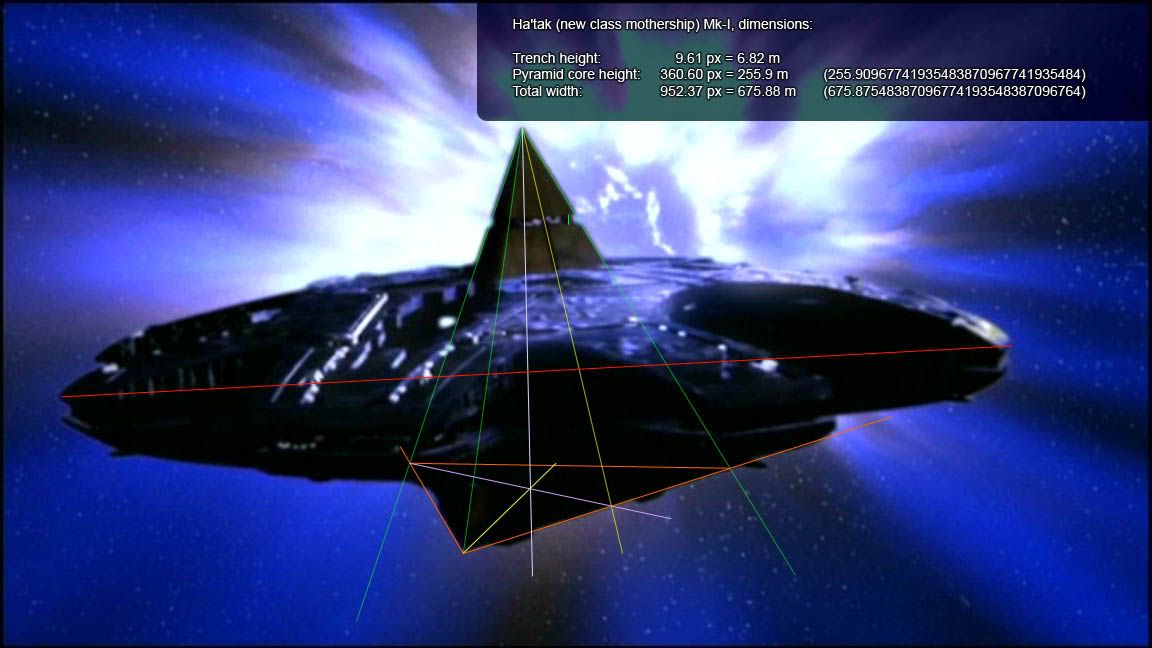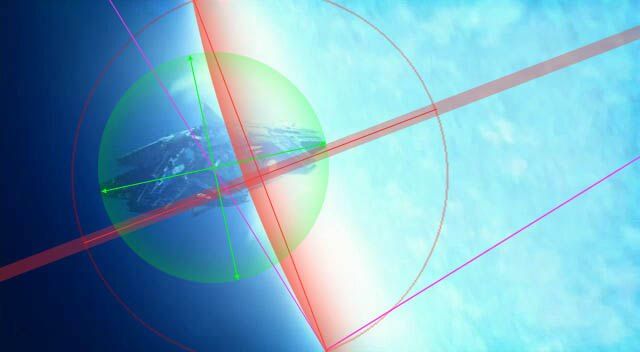Figuring out the yield of Apophis' supership's destruction
Posted: Sat Mar 10, 2007 4:47 pm
Remember the first episode Enemies, from the firth season.
There, both SG-1 and Apophis jump out of hyperspace 4 million light years away from intended plot point, because of the destruction of Vorash's sun, which propelled both ships farther than planned.
They end in a part of a galaxy controlled by Replicators. They control an alien ship which attacks Apophis' supership, a much bigger and much more powerful ha'tak.
That supership is basically an advanced, superior, ha'tak, something like 3.65 times bigger than a standard ha'tak.
We learn this:
This can only mean that the supership's weapons are far more powerful.
Apophis sets the self destruct on, and the Replicators can't reprogram the ship fast enough to stop it. SG-1, as they had boarded the ship, realize this, and try to escape as fast as possible.
Here's how things roll out, once they're back inside Cronos' ship:
First, Apophis' ship was so far away that we couldn't see it just before it exploded.
Secondly, as the ha'tak got its engines shut off, and slowed down (inertia dampeners, same as the tech on puddle jumpers or Murio's cargo), the wave splashed against its shields, and this pushed the ship. Slightly, but noticeable up to the point where it moved a bit faster after being hit, and banked a little bit.
Thirdly, it was clearly a case of life or death, as shields were absolutely necessary. This means the ship could have not protected the crew without shields, yet it succesfully protected the crew for one hour when sitting close to a blue giant.
So we're talking about an important level of kinetic due to a flux of unknown particles, released from an explosion that occured far far away.
That has to be measurable, with mass, displacement over time and thus acceleration, or the levels of energy calced for ha'tak shields (what was it, several megatons per second, right?) and the inverse square law regarding the distance between the ha'tak and the supership.
What's the eye's maximum sight range, roughly?
If we need to estimate an acceleration, what's the most conservative size for a ha'tak? I had one which was about a 675.88 meters wide ha'tak, for a height of 255.9 meters. What amount of mass could we get from that, depending on the materials we'd consider?
There, both SG-1 and Apophis jump out of hyperspace 4 million light years away from intended plot point, because of the destruction of Vorash's sun, which propelled both ships farther than planned.
They end in a part of a galaxy controlled by Replicators. They control an alien ship which attacks Apophis' supership, a much bigger and much more powerful ha'tak.
That supership is basically an advanced, superior, ha'tak, something like 3.65 times bigger than a standard ha'tak.
We learn this:
Note: all ha'taks have enough power to penetrate another ha'tak's shields, even at full power, over time.JACOB: He's arming weapons.
JACK: Shields?
JACOB: Not responding. Not that they'd do much good anyway. That ship has weapons powerful enough to penatrate our shields at full power.
This can only mean that the supership's weapons are far more powerful.
Apophis sets the self destruct on, and the Replicators can't reprogram the ship fast enough to stop it. SG-1, as they had boarded the ship, realize this, and try to escape as fast as possible.
Here's how things roll out, once they're back inside Cronos' ship:
Two important things to know.INT—CORRIDOR, KRONOS' MOTHERSHIP
[Carter, O'Neill and Jacob are running down the corridor.]
CARTER
There's not enough time to fix the hyperdrive, is there?
JACOB
We're going to have to hope the sublight engines can get us far enough away.
CARTER
Of course, that's only going to matter if the replicators can't shut down the auto- destruct.
JACOB
They'd have to learn to reprogram a Goa'uld computer awfully quick.
[They run onto the bridge.]
CARTER
It's possible, if they get control of that ship.
O'NEILL
Hey! You guys are just being too negative!
JACOB
We're not going to make it!
DANIEL
Going as fast as we can.
EXT—SPACE
[SG-1's ship is flying away from Apophis' mothership as it explodes.]
INT—BRIDGE, KRONOS' MOTHERSHIP
JACOB
Right, shut down the engines, divert full power to the shields!
DANIEL
(stepping out of his way)
Be my guest.
[Jacob takes the controls.]
EXT—SPACE
[The orange glow of the shields appear just as the blast wave from Apophis' ship washes over them, leaving them undamaged.]
First, Apophis' ship was so far away that we couldn't see it just before it exploded.
Secondly, as the ha'tak got its engines shut off, and slowed down (inertia dampeners, same as the tech on puddle jumpers or Murio's cargo), the wave splashed against its shields, and this pushed the ship. Slightly, but noticeable up to the point where it moved a bit faster after being hit, and banked a little bit.
Thirdly, it was clearly a case of life or death, as shields were absolutely necessary. This means the ship could have not protected the crew without shields, yet it succesfully protected the crew for one hour when sitting close to a blue giant.
So we're talking about an important level of kinetic due to a flux of unknown particles, released from an explosion that occured far far away.
That has to be measurable, with mass, displacement over time and thus acceleration, or the levels of energy calced for ha'tak shields (what was it, several megatons per second, right?) and the inverse square law regarding the distance between the ha'tak and the supership.
What's the eye's maximum sight range, roughly?
If we need to estimate an acceleration, what's the most conservative size for a ha'tak? I had one which was about a 675.88 meters wide ha'tak, for a height of 255.9 meters. What amount of mass could we get from that, depending on the materials we'd consider?
 (I can't remember where I put the calcs I used to obtain the pel'tak trench height though).
(I can't remember where I put the calcs I used to obtain the pel'tak trench height though).
